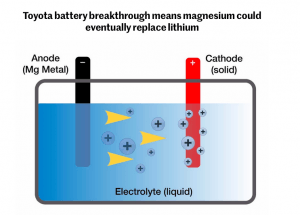
By Aaron Turpen,
Engineers at the Toyota Research Institute of North America (TRINA) think they’ve found the secret to using magnesium in rechargeable batteries. This would replace lithium as a safer, more energy-dense option for batteries in everything from cell phones to cars.
Magnesium has been considered a potential replacement for lithium in rechargeable batteries for some time. Lithium is not stable in air and can combust when exposed, so to make lithium-ion batteries safer, the ions are reduced and the lithium is embedded into graphite rods. This reduces the amount of metal (reducing density), which limits the amount of power the li-ion battery can store. To increase density, engineers have toyed with the mix of lithium and graphite and the shape of the cells, but the balance is tricky.
Magnesium, on the other hand, is stable in the atmosphere and more potentially energy dense than is lithium in terms of storage. The trouble is, forming an electrolyte that doesn’t degrade the magnesium while offering efficient transfer had proven difficult – until a chance discovery during research into hydrogen fuel cells changed that.
Principal scientist and chemical engineer Rana Mohtadi of Toyota overheard colleagues discussing the challenges of developing a magnesium-friendly electrolyte. She realized that the properties of the hydrogen storage material she’d been working with might be conducive to a magnesium-based battery. They formed a team and set to work to test it.
The manager for Toyota’s research group, Paul Fanson, attributes the discovery to the diversity of the research staff at TRINA and the collaborative nature of the facility’s culture.
The team has produced a paper outlining the discovery, which was published in the Angewandte Chemie International Edition. They hope that other researchers outside of Toyota can find use in the material and hasten the development of usable magnesium-based batteries. There is still some way to go before we’ll be slotting magnesium batteries into our smartphones with the researchers estimating that it could be 20 years before these batteries go mainstream. The hope is that making the discovery public may help speed up that timeline.
Learn more in the video below:
